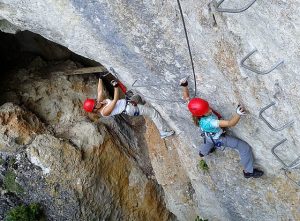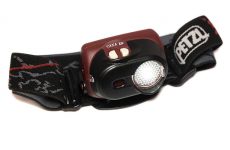
Via Ferrata, meaning “iron road” in Italian, is a thrilling way to explore the mountains. It is a climbing route equipped with steel cables, metal rungs, and ladders that allows climbers to reach otherwise inaccessible parts of the mountains. Via Ferrata routes provide a safe and exciting way to experience the beauty of the mountains, even for those who do not have advanced climbing skills.
The History of Via Ferrata
Via Ferrata dates back to World War I when soldiers used them to cross the treacherous mountains in the Alps. After the war, the Via Ferrata routes became popular among mountaineers who used them as a way to explore the mountains safely. Today, Via Ferrata routes are available all over the world, and they have become a popular outdoor activity for adventure seekers.
One of the most thrilling aspects of Via Ferrata climbing is the exposure to heights. Climbers can experience vertigo-inducing drops and breathtaking views from high up on the mountains. The experience of climbing a Via Ferrata route is a unique one, and it requires physical strength, balance, and concentration. It is a great way to challenge yourself physically and mentally, and the sense of accomplishment at the end of the climb is exhilarating.
Via Ferrata Equipment
To tackle a Via Ferrata climb, you need to be equipped with a harness, helmet, and Via Ferrata set.
The Via Ferrata set is a specialized device that consists of two lanyards with carabiners that attach to the steel cables on the route. The set acts as a safety measure by keeping you attached to the cable at all times.
To use a Via Ferrata set, clip the via ferrata lanyard to your harness and follow the steel cable, which is fixed to the rock, using special carabiners. You should always have at least one carabiner clipped onto the cable at all times to ensure your safety. Move along the route, step by step, following the cable and using the rungs and other aids fixed to the rock, until you reach the end of the route.
The Black Diamond Iron Cruiser Via Ferrata Set is a specialized climbing equipment designed for Via Ferrata climbing. It consists of two lanyards that connect to a central energy-absorbing system that minimizes the force of any falls, two carabiners for attaching to the steel cables, and an elastic sling that keeps the lanyards organized and compact.
The lanyards are made of high-strength nylon webbing and are adjustable in length to accommodate different sections of the Via Ferrata route. The carabiners are specially designed to prevent accidental opening and feature a keylock nose for easy clipping and unclipping.
The Iron Cruiser Via Ferrata Set is rated for users weighing between 40 and 120 kilograms and is certified to meet international safety standards for Via Ferrata climbing.
The Petzl Scorpio Vertigo Via Ferrata Lanyard is another specialized climbing equipment designed for Via Ferrata climbing. This Via Feratta set consists of two retractable lanyards that can extend up to 2 meters in length, and it has a total weight of 380 grams. The retractable design helps to keep the lanyards out of the way when not in use, reducing the risk of tripping or getting snagged on nearby objects.
The Petzl Scorpio Vertigo Via Ferrata Lanyard includes Petzl’s Vertigo Wire-Lock carabiners, which are designed to facilitate clipping and unclipping from the steel cables of the Via Ferrata route. The carabiners feature a large gate opening and a keylock system to prevent snagging on the cable. The energy absorber of the Scorpio Vertigo is located on the lanyards, while the Iron Cruiser has a central energy-absorbing system.
Via Ferrata Routes
The Via Ferrata routes are graded according to their level of difficulty, and there are routes suitable for all levels of experience. Beginner routes are designed to be easy and accessible, while intermediate and advanced routes offer more challenging climbs. The difficulty of the climb depends on factors such as the steepness of the terrain, the length of the route, and the height of the cliffs.
Via Ferrata routes are not only an exciting way to explore the mountains; they also offer a unique perspective on nature. Climbers can experience the mountains in a way that is not possible through traditional hiking trails. The steel cables and metal rungs provide access to remote areas that would otherwise be inaccessible, and the views from these vantage points are unforgettable.
The World’s Best Via Ferrata Routes
Each of these Via Ferrata routes offers its own unique challenges and rewards. They are all worth exploring if you’re looking for an exciting and challenging climbing experience:
- Via Ferrata de la Cala del Moli – Spain: This route is located near the coastal town of Tossa de Mar and offers stunning views of the Mediterranean Sea. It’s a moderate climb that is suitable for beginners and experienced climbers alike.
- Klettersteig Piz Trovat – Switzerland: This route is located in the Swiss Alps and offers stunning views of the surrounding mountains and glaciers. It’s a challenging climb that requires good fitness and some prior climbing experience.
- Via Ferrata degli Alpini – Italy: This route is located in the Dolomite Mountains and is known for its stunning views and challenging climbs. It’s a popular destination for experienced climbers.
- Via Ferrata du Diable – Canada: This route is located in Quebec and offers stunning views of the surrounding forests and lakes. It’s a challenging climb that requires good fitness and some prior climbing experience.
- Via Ferrata de la Curalla – Spain: This route is located in the Montsec mountain range and offers stunning views of the surrounding valleys and canyons. It’s a challenging climb that requires good fitness and some prior climbing experience.
- Telluride Via Ferrata – Colorado: This route is located near the town of Telluride and offers stunning views of the surrounding mountains. It’s a challenging climb that requires good fitness and experience.
- Iron Way at Mount Norquay – Banff, Canada: This Via Ferrata route in Banff, Canada is a popular destination for American climbers. It features a suspension bridge and a series of exposed climbs.
- Fisher Towers Via Ferrata – Utah: This route is located near Moab and offers incredible views of the famous Fisher Towers rock formations. It’s a challenging climb that requires a good level of fitness and some prior climbing experience.
- Via Ferrata at Nelson Rocks Outdoor Center – West Virginia: This is one of the most popular Via Ferrata routes in the eastern United States. It features several suspension bridges and a 200-foot-long zipline.
- Mount Ogden Via Ferrata – Utah: This route is located near Salt Lake City and offers stunning views of the city and the surrounding mountains. It’s a challenging climb that requires good fitness and experience.
- Via Ferrata at Kicking Horse Mountain Resort – British Columbia, Canada: This route in Canada is accessible to Americans and offers stunning views of the surrounding mountains and valleys. It features a suspension bridge and a 200-foot-long zipline.
These routes offer a range of difficulty levels and stunning views, making them popular among adventure-seekers and climbing enthusiasts. Via Ferrata climbing should only be attempted with proper equipment and under the guidance of experienced professionals.
In Conclusion
Via Ferrata climbing is an exciting and safe way to explore the mountains. It offers a unique way to experience the beauty of nature and a thrilling sense of adventure. Whether you are a beginner or an experienced climber, there is a Via Ferrata route that will challenge and inspire you. So, if you are looking for an adrenaline-packed outdoor adventure, consider trying Via Ferrata climbing.


